Baseball Recruiting: How to Find and Develop Talented Players
Reading Time: 9 minutes
Reading Time: 9 minutes
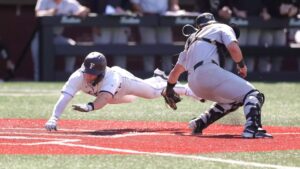
Are you a baseball coach or recruiter looking to scout and develop talented players for your team?
In this blog post, we’ll explore the ins and outs of baseball recruiting, discussing practical strategies for identifying promising athletes and nurturing their skills to build a strong and competitive team.
Let’s get started.
Understanding the Baseball Recruiting Landscape

College baseball recruiting has become increasingly competitive due to evolving trends in sports and the changing approach of programs in how they evaluate and scout athletes.
As college programs strive to build competitive teams they learn that talent identification in baseball recruiting extends far beyond player statistics.
The competitive nature of college baseball recruiting
The college baseball recruiting process can be intense, with numerous talented athletes vying for limited spots on rosters each spring.
College coaches evaluate players based on their on-field performance and potential to contribute to the team’s long-term success.
As a result, student-athletes must be proactive, strategic, and exceptionally skilled to stand out in the college recruiting process.
Key attributes of talented players
To discover baseball talent, it’s important to consider more than just basic stats. For college-level baseball, players need to have a mix of key qualities, including:
- Technical skills
- Physical attributes
- Game intelligence
- Consistency
Players who excel in these areas early on are more likely to attract the attention of college baseball scouts and coaches.
The importance of character and work ethic
A high school baseball player’s character and work ethic are important in college baseball recruiting. College coaches look for athletes who are dedicated to their craft, positive towards their teammates, and resilient against adversity.
Student-athletes should be able to handle setbacks and maintain a focused, determined attitude. This defines their potential to make a positive contribution both on and off the field.
Effective Baseball Recruiting Techniques

Let’s explore various strategies and approaches that can help coaches and recruiters attract talented players to their baseball programs.
- Attend camps, showcases and tournaments: These events allow a coach to see players in action, assess their skills in real-game scenarios and gauge their performance under pressure.
- Live scouting vs. video scouting: Live scouting gives college baseball coaches a clear view of high school players’ physical skills, teammate interaction and response to in-game situations. Video scouting offers a detailed view of a skills and allows for pin-pointed assessment of mechanics and form.
- Conducting background checks and interviews: Interviews with high school players, coaches, and teammates show a player’s dedication, leadership qualities, and ability to handle challenges. Background checks reveal academic performance and behavioral patterns.
- Evaluating pitchers mechanics and performance: Good pitching mechanics prevent injuries and lead to consistent performance. Scouts evaluate pitchers based on their ability to throw different pitches and execute in various game situations.
- Evaluating baseball hitters: Coaches and scouts seek players who make consistent contact, display power, and demonstrate the ability to hit to all parts of the field. Players must also be able to articulate their approach and how it adapts in different situations.
- Balancing immediate needs with long-term potential: A coach must manage current roster gaps, but scouts must also consider the student-athlete experience, growth potential and how they fit into the team’s identity and culture.
Baseball Recruiting Guidelines By Position
Scouts and potential players must understand the required skills for each baseball position. From the precision required of a pitcher to the versatility of a utility player, recruiting guidelines identify attributes that make a player stand out.
Pitchers

- Mechanics and delivery: A pitcher must have efficient and repeatable mechanics. Look for a clean and powerful delivery all the time.
- Velocity: Evaluate fastball velocity and compare it to others. Consider the potential for velocity development.
- Pitch repertoire: Assess the ability to throw multiple pitches – fastballs, curveballs, sliders and changeups.
- Command and control: Look for precision in hitting spots and controlling the strike zone with consistent arm action.
- Mental toughness: A good pitcher can handle high-pressure situations and bounce back from adversity.
Catchers

- Receiving skills: Catchers should receive and frame pitches to make borderline pitches look like strikes.
- Arm strength and accuracy: A college coach looks for a strong, quick arm to make accurate throws around the infield.
- Blocking skills: Take a look at proficiency in blocking pitches in the dirt and preventing passed balls.
- Game management: Consider the management of the pitching staff and communication with pitchers and infielders.
- Leadership: Look for qualities of leadership and game awareness behind the plate.
Outfielders
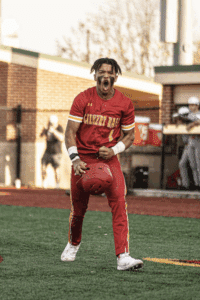
- Speed and range: A college coach should know an outfield’s speed and ability to cover ground effectively and track down fly balls.
- Fielding skills: Look for clean fielding techniques – the ability to catch balls confidently and make accurate throws.
- Arm strength: Assess the throwing arm strength and accuracy of the athlete when throwing to the infield or home plate.
- Offensive ability: An outfielder needs batting power, contact and the ability to get on base.
First Basemen

- Fielding skills: First basemen should be able to move fluidly to handle both groundballs and pop-ups. They also must have the ability to adjust to errant throws across the infield with good footwork and soft hands.
- Range and agility: Prospects have lateral movement and agility to cover the base and field balls in changing positions.
- Offensive production: A college coach evaluates their power-hitting capabilities, consistency at the plate and ability to drive in runs.
- Defensive skills: Consider how they handle high and off-target throws from infielders.
Second Basemen

- Fielding and range: Second basemen must handle ground balls, pop-ups, turn double plays and cover a significant portion of the infield.
- Quickness and agility: Look for quick reflexes and agility in reacting to the ball.
- Throwing accuracy: Second basemen need throwing accuracy and strength – on throws around the infield.
- Situational awareness and decision-making: Second basemen must have keen situational awareness to make quick, smart decisions and position themselves correctly.
Shortstops
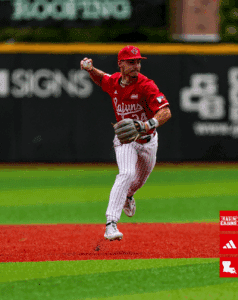
- Fielding and range: Shortstops require exceptional fielding skills and range to cover the infield.
- Arm strength and accuracy: Watch for strong, accurate throws across the diamond.
- Quick reactions: The best shortstops can react quickly to ground balls and have great footwork.
- Offensive production: Watch their hitting ability, contact, power and contribution to the offense.
Third Basemen
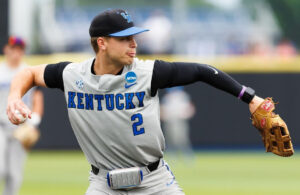
- Fielding skills: Third basemen must field hard-hit ground balls and handle bunts.
- Reaction time: Evaluate their quick reaction time and how the athlete makes plays on sharply hit balls.
- Arm strength: Third basemen must make strong and accurate throws to first base and around the infield.
- Offensive contribution: Consider how recruits hit for power and drive in runs on offense.
Utility Players
- Versatility: Recruits should play multiple positions and adapt to different roles.
- Fielding skills: Utility recruits have solid defensive skills at many positions.
- Offensive ability: A utility recruit makes contact with the baseball, has power and has plus base-running abilities.
- Adaptability and work ethic: Pay attention to their willingness to take coaching and commitment to improving.
How College Coaches Build Relationships with Prospects
Building solid relationships with potential recruits is a requirement for successful college baseball recruiting. A college coach must communicate effectively and personalize their approach to attract and retain the best matches for their program.
- Effective communication strategies: Effective communication builds trust with each recruit. A college coach should use respectful, clear and consistent messaging. Give families regular updates, personalized notes, and prompt responses to inquiries.
- Personalizing your approach: Tailor your communication to each prospect’s interests, strengths and goals. Show genuine interest in their personal development and achievements. Explain how your program is a good fit with their aspirations for freshman year and beyond.
- Setting clear expectations and goals: Be transparent about the college recruiting process and what you expect from recruits as a college student. Tell baseball players what they can expect from your program. A college coach should clearly outline the goals and standards for players on the field and in the classroom.
- Addressing player concerns and questions: Provide thorough and honest answers to any concerns or questions the prospect and their families may have. Whether it’s about playing time, academic support in class or the college recruiting process – address these issues openly.
- Involving the player’s family: A college coach needs to engage with prospective families to build a support system and ensure that all parties are informed and comfortable with the college baseball recruiting process. Family involvement is key in players’ decision-making about where they will play baseball.
- Ensuring compliance with baseball recruiting regulations: Colleges must adhere to all NCAA and conference recruiting rules and regulations during the recruiting calendar. This ensures that college baseball recruitment practices are fair, transparent and in accordance with college governing body standards.
Developing Recruited Talent
After recruiting a player, it’s important to focus on nurturing their growth and maximizing their potential as a college athlete.
It involves developing a personalized development plan, setting clear goals, implementing position-specific training, and integrating strength and conditioning programs into college practices.
Creating a development plan
Implementing a well-structured development plan is a fantastic method for nurturing baseball talent.
This plan should clearly outline the player’s developmental pathway, encompassing technical skills, tactical skills, video analysis, understanding, and personal growth.
Coaches should assess each player’s current abilities, pinpoint areas for improvement, and devise a custom plan that corresponds to the player’s strengths and weaknesses.
Setting short-term and long-term goals
Establishing clear short-term and long-term goals helps track progress and maintain motivation to play baseball.
Short-term goals focus on specific skills or areas of improvement, such as enhancing batting technique or refining pitching mechanics.
Long-term goals align with the player’s overall career aspirations, such as achieving a starting position, securing a scholarship or reaching professional levels.
Baseball coaching involves regularly reviewing and adjusting these goals so that the team remains focused and on track.
Implementing position-specific training
Position-specific training helps develop specialized skills for each position. A college coach should design drills and exercises tailored to every role on the field. Make training programs that improve a catcher’s receiving skills, a pitcher’s mechanics or an outfielder’s range.
Strength and conditioning programs
A strength and conditioning program boosts athletic performance and prevents injuries. A good program builds strength, increases flexibility and improves endurance.
Implementing GoRout into baseball practices and games
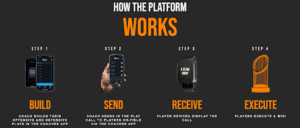
Effective communication on the baseball field is essential for success. GoRout Diamond is a cutting-edge baseball pitch-calling system that improves coach-to-player communication and team coordination in practices and games.
GoRout simplifies communication by allowing coaches to communicate game strategies – pitch calls, defensive shifts, bunts, steals, and hits – with just a single tap.
GoRout helps players receive real-time, encrypted signals from the coach’s app to minimize confusion and errors during high-pressure moments. This baseball communication system helps players focus on execution rather than deciphering hand signals or verbal cues.
GoRout coaches application
The GoRout coaches application is designed for ease of use and efficiency. With just one tap, coaches can quickly send pitch calls, set up defensive shifts and signal offensive plays.
Its intuitive, user-friendly interface allows for smooth communication so coaches can relay instructions to catchers, pitchers, runners and the entire team on game day or during practices.
GoRout player devices
GoRout equipment and baseball communication devices are designed for simplicity and reliability. They require no setup, pairing or programming. Each device comes fully encrypted and ready to receive pitch calls right out of the box.
Baseball recruiting with GoRout
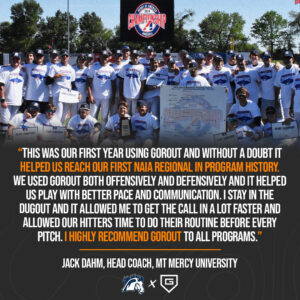
GoRout Diamond, an electronic pitch-calling system, facilitates seamless communication through encrypted pitch-calling devices. This allows coaches to relay information directly to players without the traditional signals that can often lead to confusion.
This technology is particularly beneficial in high-pressure situations, where clear communication is crucial. By using GoRout, players can focus on executing plays rather than deciphering signals, leading to improved performance on the field.
Familiarity with GoRout technology can enhance high school athletes’ recruiting profiles. College coaches increasingly seek players adept at using modern tools, which indicates readiness for the collegiate level.
Testimonials show how the GoRout Diamond helps teams win games and recruit the best players.
Get a quote today, improve your baseball recruiting process and achieve more wins.
Mentorship and continuous feedback
Coaches need to give ongoing, constructive feedback on players’ performance, pointing out their strengths and areas for improvement.
Through open communication and regular check-ins, players can receive the support they need to develop their skills and confidence on the field.
Conclusion About Baseball Recruiting
The recruiting process in college baseball is what builds successful teams. It’s important to know what key attributes players should have, how to keep in touch with them throughout the recruitment season and how to continue their development once they have made the team.







